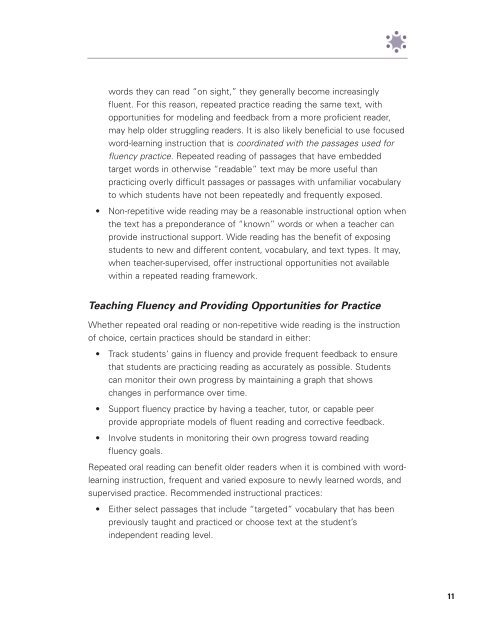Practice Brief-Struggling Readers.pdf
Practice Brief-Struggling Readers.pdf
Practice Brief-Struggling Readers.pdf
Create successful ePaper yourself
Turn your PDF publications into a flip-book with our unique Google optimized e-Paper software.
words they can read “on sight,” they generally become increasinglyfluent. For this reason, repeated practice reading the same text, withopportunities for modeling and feedback from a more proficient reader,may help older struggling readers. It is also likely beneficial to use focusedword-learning instruction that is coordinated with the passages used forfluency practice. Repeated reading of passages that have embeddedtarget words in otherwise “readable” text may be more useful thanpracticing overly difficult passages or passages with unfamiliar vocabularyto which students have not been repeatedly and frequently exposed.• Non-repetitive wide reading may be a reasonable instructional option whenthe text has a preponderance of “known” words or when a teacher canprovide instructional support. Wide reading has the benefit of exposingstudents to new and different content, vocabulary, and text types. It may,when teacher-supervised, offer instructional opportunities not availablewithin a repeated reading framework.Teaching Fluency and Providing Opportunities for <strong>Practice</strong>Whether repeated oral reading or non-repetitive wide reading is the instructionof choice, certain practices should be standard in either:• Track students’ gains in fluency and provide frequent feedback to ensurethat students are practicing reading as accurately as possible. Studentscan monitor their own progress by maintaining a graph that showschanges in performance over time.• Support fluency practice by having a teacher, tutor, or capable peerprovide appropriate models of fluent reading and corrective feedback.• Involve students in monitoring their own progress toward readingfluency goals.Repeated oral reading can benefit older readers when it is combined with wordlearninginstruction, frequent and varied exposure to newly learned words, andsupervised practice. Recommended instructional practices:• Either select passages that include “targeted” vocabulary that has beenpreviously taught and practiced or choose text at the student’sindependent reading level.11


